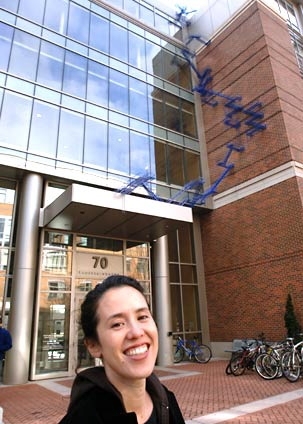Sarah Sze, internationally acclaimed sculptor and installation artist and winner of a 2003 MacArthur "genius" award, has installed a whimsical miniature fire escape on the front of MIT's Sidney-Pacific Graduate Rsesidence.
The new work, commissioned by MIT's Percent-for-Art Program, is titled "Blue Poles," in honor of Jackson Pollock's 1952 drip painting by that name. Made of small blue steel ladders, balconies and stairways welded into fire-escape-like clusters, "Poles" climbs to the roof of the six-story building from just above the front door.
Sze discussed her MIT work at an opening reception held at the graduate residence on March 14.
A Boston native, Sze, 37, is widely known for her intricate, site-specific installations that hold galaxies of flotsam and jetsam in suspended animation. "Blue Poles" has a more direct, illustrative quality than Sze's other work.
She approached the MIT project by exploring the space, she said. "It's a kind of nondescript building, yet popular -- students like it. I wanted to give their dorm personality in its context and to emphasize playfulness and spontaneity. I hope it gives the building character."
"Blue Poles" certainly gives anyone looking at the building an altered sense of scale and perspective. The artist's two favorite views are "looking straight down into the piece as it tumbles into space" and looking at it from the inside of the dorm, so the patterns and grids formed by surrounding buildings suddenly look "strangely huge," she said.
Sze's first installation combined wit and menace in an ephemeral 1991 piece constructed with friends during the first Gulf War and destroyed by nature within a few days. "We built a grid of 10,000 cocktailsized American flags to blanket a lawn at Yale. It was a fun piece, definitely a sneaky piece, and political, unlike my other work. It disintegrated into the grass."
Since that time, Sze's installations have been in solo exhibitions in New York, London, Paris and Boston and in group exhibitions in the Whitney and Venice Biennials.
Sze made "Blue Poles" during a yearlong residency at Alexander Calder's former studio in Sachet, France. The famed creator of mobiles and stabiles had a foundry next door, and it was there that Sze realized her plan to build her MIT piece as a "system, like an erector set, so we wouldn't have to use a crane. We brought it to the site as a 65-piece kit, welding some into clusters and popping in others where there were gaps," she said.
Sze described her own work as related to Calder's in its focus on gravity and air and play. "Calder's is a hard trail to follow, because those mobiles are so strong," she said. ("The Big Sail," a 1965 stabile by Calder, is in McDermott Court at MIT.)
In designing "Blue Poles," Sze was inspired by her childhood memories of fire escapes on apartment buildings near her home, she said.
Those rickety iron or wooden structures, used both as places to relax and as escape routes, are rarely found on new buildings; "Blue Poles" reconnects the Sidney- Pacific residence to its urban past and to the myriad ways people adapt to crowding, anonymity and summer heat.
A version of this article appeared in MIT Tech Talk on March 22, 2006 (download PDF).






